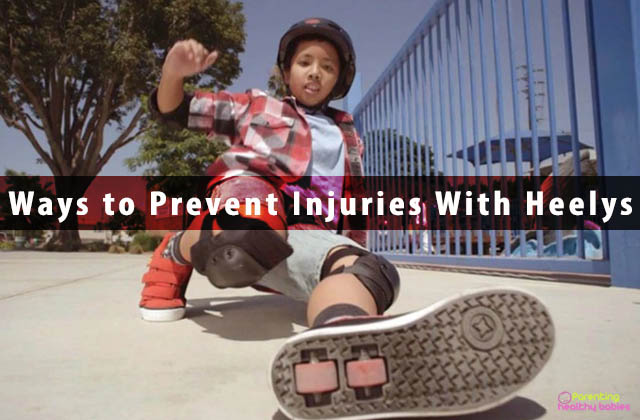It is important that your kids know how to prevent injuries whilst wearing Heelys. Injuries can be prevented if your kid staggers his/her feet whilst heeling. It is very important as otherwise he/she might just fall and incur a nasty injury. The second rule is to wear safety equipments no matter what.
You must not let your kid compromise on the safety equipments like helmet or a knee guard because any fall might prove to be quite fatal. Also you should do well not to leave the wheels on all the time in the Heelys worn by your child. It will tempt him/her to stake more impulsively thereby increasing the risk of injury.
Do not allow your child to use Heelys on slippery surfaces specially ice or roads wet after rain. The lack of friction can cause a great stumble. Also make sure that your child does not use the Heelys inside the home. If he/she runs on to some item like a mirror or a dining table then it might cause some fatal injuries.
Heelys Kids Shoes: Safety and Preventing Injuries
Sometimes the results are irreversible and you do not want that to happen to your child.
Make sure he/she staggers along
Staggering is very important when you are wearing heelys. Your child must put one foot in front of the other whilst he/she is moving forward in his/her heelys. It is a constant process that they must continue whilst they are making a forward movement. (lenehan, 2007)
When they bring both the feet together they are more likely to fall. Studies show that the momentum acquired from wearing heelys is a continuous process. It cannot be put to a brake all of a sudden. That is why it is important that you tell your child to stagger along when he/she is in his/her heelys.
Movement is very crucial in case of heelys. One foot in the front whilst the other at the back. Then your child needs to repeat the motion. In this way he/she needs to move forward. That is the physics behind heelys. If your child follows this simple method then he/she will be less likely to fall. (aarons, 2008)
Safety equipments are a must
Whilst your child is on their heelys they must wear adequate safety equipments. That is a sort of a rule. You cannot let your child wear heelys without a helmet. The other safety equipments in the form of knee pads and elbow pads are also quite important.
Experts suggest that the child must also wear a wrist guard, especially when he/she has just started to ride the heelys. This is due to the fact that in most occasions the child will fall on his/her hands. So, there is a possibility that the wrists might get fractured. Riding heelys without these safety equipments is quite risky. It is something all parents must considering whilst gifting their children with such shoes.
Even when they get used to the shoes, they must not be allowed to go out without the helmets. The helmets are the minimal essentials that they need to put on to prevent any sort of serious injury. (sheehan, 2007)
Do not leave the wheels on all the times
We understand that it is tempting for your child to run on the wheels once he/she gets hold of the heelys, but it is better not to take the risk. If the wheels are on all the time then your child might not be able to suppress the urge of skating around all the time. . (lenehan, 2007)
Being always on the wheel increases the risk of injuries. Your child is likely to fall more if the wheels are on. It does not necessarily mean that the wheels should be completely removed. But put back the wheels only when your child is fully equipped with proper protection from his/her head to knees.
In this way the impact of injuries can be decreased. Many children refuse to take the safety equipments as they think it is an extra burden or it is something which will make them look un-cool. However, you as a parent need to play the role of the bad cop. Make a rule that the wheels will get attached only if your child agrees to put all the safety equipments.
Avoid slipper surfaces
Discourage your child to be out in heelys if it snows or rains outside. When the track is slippery the risk of accidents increases. Your child is more likely to fall down and break a bone when running on heelys on a slippery surface. (aarons, 2008)
Experts suggest that the lack of friction in the ground makes it difficult for the kids to maintain control. So, it is easier for them to crash into a tree or a lamppost on a slipper surface. They might as well fall down and hurt their head.
Also the same time, the slippery surfaces increase the speed of the movement. So, it is more likely that your child will lose control and stumble. That is why it is better to pack the heelys off completely during wet weather. Heelys should be back again when the weather is dry and sunny and the roads are dry enough to skid through with even pace.
Say no to heelys indoors
As is the ground rule for all outdoor games, say no to heelys when your child is indoors. There is more than one reason to do that. Firstly the floor of your home would be much more slippery when compared to the road or the park. This would mean that your child will have less control over his/her speed or motion. This lack of control will automatically indicate that the chances of a fall will increase. (sheehan, 2007)
The second reason why Heelys should be discouraged at home is because indoors you have many obstacles to movement. Inside your home there are furniture, glass items, and even stairs. If your child crashes to any of them the risk of injury is fatal. Falling of the stairs in Heelys can not only break his/her bones but can give him/her a fatal blow on the head.
Conclusion
Heelys are always great fun for the kids. But it is always important that you take these safety precautions to prevent injuries for your kids. Educate your child about the consequences and allow your child to have fun with them by maintaining the precautions.
Reference
https://www.ncbi.nlm.nih.gov/m/pubmed/17239880/
https://journals.lww.com/pedorthopaedics/Abstract/2008/07000/Pediatric_Heelys_Injuries.3.aspx












